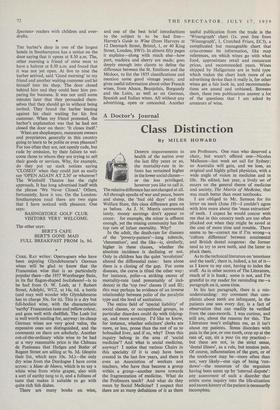A Doctor's Journal
Class Distinction
By MILES HOWARD
DESPITE improvements in health of the nation over the last fifty years or so, the mortality-rate in in- fants has remained higher in the lower social classes— or the less privileged, however you like to call it. The relative difference has not changed at all. All through epochs of war and peace, boom and slump, the 'bad old days' and the Welfare State, this class difference goes on as before. As J. N. Morris commented lately, money earnings don't appear to count: for example, the miner is affluent enough, yet the mining community has the top rate of infant mortality. Why?
In the adult, the death-rate for diseases of the 'poverty-pattern'—lung tubercle, 'rheumatism', and the like--is, similarly, higher in these classes, whether the absolute incidence is declining or not. Only in children has the quiet 'revolution' altered the differential rates: here alone there is a closing of the gap. For some diseases, the curve is tilted the other way: for instance, polio—a striking excess of mortality-rate (and presumably of inci- dence) in the 'top two' classes (I and II); this may perhaps be evidence of an inverse relationship between polio of the paralytic type and the level of sanitation.
The entire field of 'special liability' of social classes, or occupational groups, to particular disorders could do with tidying- up, and more scrutiny. I'd like to know, for instance, whether solicitors' clerks are more, or less, prone than the rest of us to hobnailed liver, and if so, why? Does this inquiry belong in the area of 'social medicine'? And what is social medicine, anyway? I notice that various Chairs in this specialty (if it is one) have been created in the last few years, and there is even an Association of workers and teachers, who have thus become a group within a group—another move towards the fragmentation of medicine. What do the Professors teach? And what do they mean by Social Medicine? I suspect that there are as many definitions of it as there
are Professors. One man who deserved a chair, but wasn't offered one—Nicolas Malleson—last week set sail for Sydney; so Australia will gain, and we lose, an original and highly gifted physician, with a wide angle of vision in medicine and in life. He edited, last year, a lively set of essays on the general theme of medicine and society, The Matrix of Medicine, that was much better than most textbooks.
I am obliged to Mr. Samson for his letter on teeth (June 19)—I couldn't agree with him more about the 'mass extraction' of teeth. I expect he would concur with me that in this country teeth are too often plucked out when they might be saved at the cost of more time and trouble. There seems to be—correct me if I'm wrong—a 'culture difference' between continental and British dental surgeons: the former tend to try to save teeth, and the latter to pluck them.
As to the technical literature on 'emotions and the teeth', there is, indeed, a lot of it— as I know to my cost, having to index the stuff. As in other sectors of The Literature, much of it is bunk; some is not, and I'm grateful to my reader for reminding me—a paragraph on it, some time.
In his last paragraph, there is a mis- understanding: my comment that com- plaints about teeth are infrequent, in the patients one sees every day, is a fact of observation that can readily be verified from the case-records. I was curious, and still am, about the reasons for this. The Literature won't enlighten me, as it isn't about my patients. Stress disorders with pain in the jaw, or one tooth, crop up at the rate of, say, six a year (in my practice)— but these are not, in the strict sense, 'dental illness', as a rule, but tension pain. Of course, inflammation of the gum, or of the tooth-root may be—more often than not, very likely—one sign of being 'run- down'—the resources of the organism having been eaten up by 'internal dispute': any assessment of such a disorder that omits some inquiry into the life-situation and recent history of the patient is necessarily incomplete.






































 Previous page
Previous page